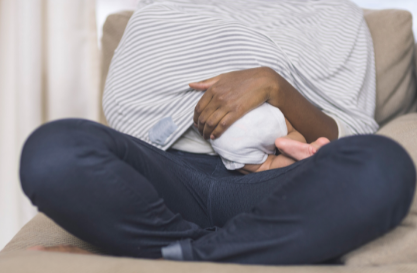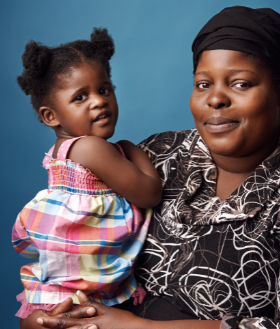
![]() Eunice ArchibongMaternal and Neonatal Care, Weight LossMay 30, 2022
Eunice ArchibongMaternal and Neonatal Care, Weight LossMay 30, 2022
One of the most dramatic changes your body will definitely experience is during pregnancy. Just within a span of a few months, you could weigh 10 to 14 kilograms more than you normally do.
Towards the end of pregnancy, the uterus and its lining will expand some 400 times their normal size, thereby greatly distending the abdomen.
While the transition from being pregnant to being a mum may happen overnight, it takes weeks or even months for the body to recover from pregnancy and childbirth.
New mothers are usually apprehensive about losing the extra kilograms they gained during pregnancy to look as fit as they used to be.
Though about five to seven kilograms come off immediately after childbirth, it could take another six to seven weeks subsequently to shed off a considerable amount of weight. The first questions many ask are: How do I go back in shape? Which exercises for weight loss for new mums should I practice?
Getting back to ”normal” after childbirth is a process that transcends just drafting a good workout routine.
While the enthusiasm for a workout plan increases, it is worthy to note that proper breastfeeding plays a crucial role in the journey of weight loss for mums alongside offering the new born babies adequately balanced nutrition and fortifying infants against diseases.
Breastfeeding also decreases a mother’s risk of developing breast cancer and ovarian cancer. Since energy is required for a healthy production of breast milk, nursing moms should eat an additional snack, like a cup of yoghurt or a piece of fruit, to get an additional 300 calories daily.
Don’t worry, breastfeeding will help you lose baby weight even with this extra food, as long as you’re eating healthy and not overdoing it.
Weight loss for new mums can be challenging, however, understand that women have nine times more estrogen than men, and men have 16 times more testosterone than women. Estrogen puts that fat around women; it gives women their characteristics, especially in the lower part of the body, the arms, and breast tissue. Testosterone gives more body mass.
So women need to exert at least double the effort to lose weight. If you have too much estrogen in your body, which is called estrogen dominance, this occurs not because the estrogen level is going up but because the progesterone and testosterone are going lower, making the ratio of estrogen higher. Then you create the estrogen effect and start gaining more weight.
There are some hormonal interacts that can make weight loss for new mums a little bit challenging. The adrenal gland is responsible for making estrogen and progesterone. Estrogen dominance affects the thyroid, inhibiting its functions. The thyroid controls your metabolic functions, and not having it at its full function can slow your ability to lose weight. Ensure you are not estrogen dominant; that way, you can lose weight faster. Ensure that you lower your insulin levels within your body.

The answer to this question usually depends on the method of delivery; C-section or vaginal delivery. A healthy pregnancy and a normal vaginal delivery somewhat guarantee that you can start exercising sooner than later.
According to the American College of Obstetricians and Gynaecologists, you can begin exercises within a few days of normal vaginal delivery whenever you feel ready to commence.
Taking a 10 to 20- minute daily stroll around the neighbourhood, with or without your baby is a great way for many new mums to build up stamina for more tedious exercises. Getting about 3 hours of exercise a week, say around five weeks postpartum, is a good goal, just like for all adults.
For mums who had complications or delivered their babies by C-section, there’s a need to take it slowly so that the stitches can heal properly. It is in your best interest to Consult a Doctor, midwife or physical therapist to give you some personalized advice.

After nine months of being stretched out, your abdominal muscles need to first learn how to function appropriately again.
Hence, shedding off the baby weight, staying fit or getting back to the rigorous workout routine you practiced before you were pregnant, requires retraining the pelvic floor — which involves engaging in core exercises.
Kegel exercise is the best for training your core; forget crunches and sit-ups. Contract and relax the muscles of your pelvic floor as often as you can.
Simply squeeze your core as if you’re trying to stop the flow of urine, making an effort to draw your pelvic floor up.
Hold this position for three to five seconds. Then relax. Regaining core function is an essential bedrock for maintaining good bladder control when you’re running, coughing or sneezing.
After getting the hang of kegels, try adding belly breathing exercises. Inhale deeply while letting your belly expand and relax your core. Then, exhale, drawing your abdomen in and your pelvic floor up.
Stomach vacuum exercises also help lose belly fat quicker. The best way to position yourself for this exercise is by standing up straight with your feet shoulder-width apart, then slowly breathing in and out of your nostrils.
Suck in your bellybutton as far in as possible, with your rib cage raised, and keep at this position for about 20 minutes before exhaling slowly through your nostrils.
You can repeat this exercise several times daily, in the comfort of your home. This exercise also helps straighten your spine and reduce backache. Perfect, isn’t it?
On the matter of stretch marks, applying retinoid creams extracted from vitamin A can minimize the appearance of new stretch marks (not less than a few weeks old) and fade off older ones.

Finding time to exercise, especially when there’s an infant with constant demands, is quite a challenge. Nonetheless, here are some ways to swing it:
1. Set a realistic workout routine. This could be a 20minutes plan divided into mornings and evenings each day. Take it slowly, one day at a time, at good paces.
No matter how anxious you are to lose your baby fat, health professionals caution against any activity that puts major stress on your joints for at least six to eight weeks postpartum.
This is because the hormone relaxin (relaxin makes joints loose and more prone to injury) that was produced during pregnancy would take up to six weeks after delivery before being completely flushed out of your system.
2. Eat lots of fruits while incorporating dietary supplements into your diet. Remember to also drink enough water throughout the day.
3. The elastic walls of the vagina stretch quite a bit during childbirth but spring back into place thereafter. Sex is also considered a great form of exercise, so you can resume sexual intercourse when you feel ready and have gotten the go-ahead from your doctor. But while at it, keep in mind your birth control plans.
4. Try a mum and baby class. Mommy-and-me fitness classes offer benefits beyond the workout. You get to be active while spending time with your baby. You’ll meet other new parents who’ll be excited to share their experiences. Good communication keeps you active as well as helps combat any form of postpartum depression.
5. Ensure you give yourself the support you need by asking for help whenever you’re feeling overwhelmed. Letting your partner or someone else support you is healthy for you.
As new mums search for ways to lose some weight they accumulated during pregnancy; telemedicine provides you with access to a distant healthcare professional, like a nutritionist, psychologist, psychiatrist, or therapist.
Telemedicine brings you whatever you need to take care of yourself without much discomfort. It reduces the degree to which your time, energy, and transportation are spent. From the comfort of your home or office, consult a doctor.
1. How can I regain my weight after giving birth?
To get back to a healthy weight, all you may need is a nutritious diet and frequent exercise. However, consult your physician before beginning any kind of activity or diet program. It is advisable to wait until your child is at least two months old if you wish to eat while breastfeeding.
2. Why is it harder to lose weight after having a baby?
Hormonal imbalances are the root cause of postpartum weight loss problems for many women. Pregnancy alters hormone levels dramatically. It is unlikely that your hormones will return to normal the moment your little one arrives. In actuality, the process of your hormones returning to normal can take a long time.
3. How much weight do you lose naturally after giving birth?
After giving birth, most women lose between 5 and 7kg on average, in addition to the baby and possibly subsequent placenta and amniotic fluid. You are going to continue to lose weight right from the initial week postpartum, following the loss of residual liquids.
4. What is the best diet for postpartum weight loss?
Whole grains, fresh produce, and a good amount of protein-rich foods should all be included in a regular diet. Reduce the number of empty-calorie items you eat. Drink enough water to quench your thirst and maintain a light-coloured pee. Also, keep taking your prenatal vitamins every day.
5. How do you lose belly fat after having a baby?
These exercises will assist you in preparing your body for consistent activity.
6. What foods should postpartum moms avoid?
Reduce your intake of packaged, processed foods and beverages that are heavy in added sugars, salt, and unhealthy fat. You must also obtain adequate protein, high-protein foods aid in the body’s postpartum recovery, including beans, shellfish, lean meats, eggs, and soy products.
7. How long does it take for the postpartum belly to shrink?
As your uterus contracts and your body expel any leftover fluids, you will probably shed a significant amount of that weight over the course of two months following giving birth. That being said, it may take your body up to nine months, or perhaps up to two years, postpartum to reach its initial weight.
Booth, S. (2023). New mom’s guide to nutrition after childbirth.
Bouchez, C., & Seed, S. (2024). 6 Get-your-body-back moves after childbirth.
Capland, J. (2024). How do I regain a healthy weight and shape after delivery?
Dr Berg, E. (2021). Why women lose weight slower than men.
Health partners. (2024). Postpartum weight loss: Exercise and nutrition tips to help you lose weight after pregnancy.
Her kare. (2021). 3 reasons you just can’t lose that stubborn post baby weight.
Newton-Wellesley Hospital. (2024). Postpartum diet and weight loss.
RMC Health System. (2023). When will “pregnancy belly” go away?
NutritionFebruary 5, 2025
MedicationFebruary 5, 2025








